
Wow, the last day of the 2021 edition of the EuroSTAR Conference was over in a blink. There were also offered several side events that took place in between the conference talks like tool demos, AMAs and a feedback round at the end of the day.
A special program point was the EuroSTAR 2021 Software Testing Awards ceremony. Here the winners of the awards for Best Tutorial, Best Conference Paper and the 2021 EuroSTAR Testing Excellence Award have been announced.
And last, but not least, the programme committee and location for the 2022 edition of the EuroSTAR Conference have been presented. Copenhagen in summer – how cool is that?
But now, let me show you my sketchnotes of the day and do a quick summary of the talks.
Digital happiness in the age of customer obsession
Michiel Boreel
As the world is constantly changing and with it the people and their needs, opinions an mentality, Michiel wanted us to think more about Positive Computing. Focusing on happiness as a goal of technology.
We tend to think that from trust to distrust it’s a continuum, but actually they are two different emotions that happen at the same time. Overall, trust is declining. We don’t trust organisations anymore. Also, platform trust increases (ex. Airbnb, Uber) as these platforms provide the trust that is required for the economic transaction.
People born from 1998 to 2019 build the new synthetic generation. These people don’t see a difference between online and offline. They are:
- Post-technological: it’s not an innovation anymore, but seen as given
- Post-hierarchical: they trust influencers more than companies
- Post-realistic: with AI working on images and videos, reality can be altered
- Post-materialistic: they are confronted with crisis and want to solve the issues. Now not wealth but purpose is a valued goal
Companies have to ask themselves if they are woke – are they connected to the changes that happen in society? How can you transform and get a sense of purpose? Organisations need a new story clearly articulating their valuable role in digital society.
Escape “brain hijack” – dealing productively with conflict and disagreement
Marielle Roozemond
First, let’s define disagreement and conflict. Disagreements are about the content side of issues and people take a rational approach to them. Conflicts are about the content and the values side of issues and people take an emotional approach to them. Going up the escalation stairs, it’s not a very long way from win-win situations over win-lose situations to disfunction.
A highjacked brain focuses on the argument while fewer things get to the higher levels of your brain. You have a lower empathy and you might act not like you. If so, you need to try to de-escalate on purpose and to re-activate thinking with the higher levels of your brain.
Marielle proposed 4 tools to do so:
- Activate curiosity
- Activate exploration
- Recognize and sidetrack signals from amygdala
- Change your convictions about disagreement and conflict
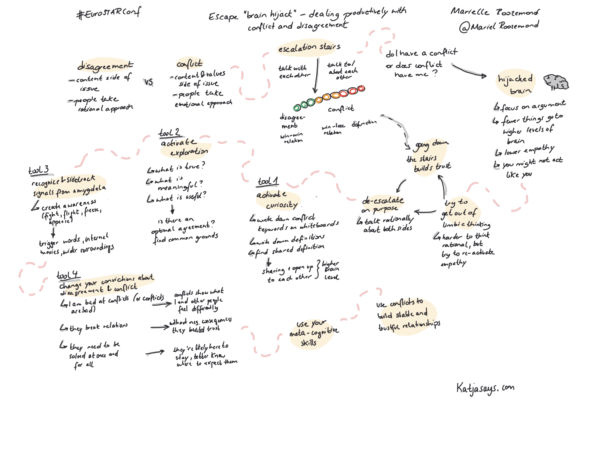
Building relationships. A Tester’s Guide to the enterprise world
Lukasz Pietrucha
Building relationships is crucial, not only, but especially when working as a tester. Lukasz has a 5 pillar concept that he presented to us:
- Start with the research: learn about business, know goals & objectives, study user reviews
- Build the connection: identify champions, carefully select meetings, socializing
- Adoption through small and simple steps: come up with a plan, POC/MVP, listen a lot, frequent reporting
- Become an influencer: share what you know, ownership/proactiveness, shape the reality – build your reputation, be visible
- Survive the storms: sometimes you need time, attach to business needs, learn from failures – build future fundamentals
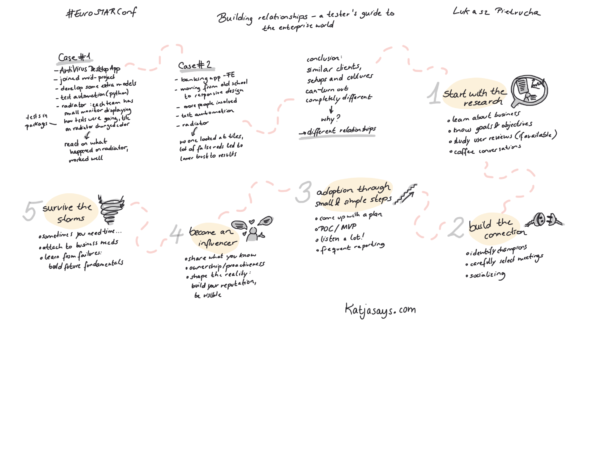
Using requirements as call to … conversations
Irja Straus
Testing begins before a single line of code is written. Testing assumptions can be helpful to determine opportunity costs and time to market. Keep in mind that correct and perfect requirements are a myth, they are prone to misunderstanding. BUT: They are a great conversation starter.
Irja likes to use “dogfooding” to get the to ground of the requirements – this basically means using your own product. The more disgusting it is, the more rewarding it gets, as you can discover more problems along the way.
Ask yourself if you have enough data that shows, that you need to build a certain feature. Will users understand what is happening and if not, how can we help them recover in case of failure? Try to simplify the workflow and think about if you could set the expectations.
A good approach is to collaborate earlier. Understand the business context, learn related skills and adapt practices that serve YOUR business. A good way of doing this is by doing product reviews. Ask the questions about design and requirements to avoid asking them after development when it’s too late/expensive to change anything.
Irja wants us to remember the following 3 things:
- Consider requirements as call to conversations to understand the purpose
- Consider learning different skills from your “monsters”
- Consider YOURSELF and what works for YOU
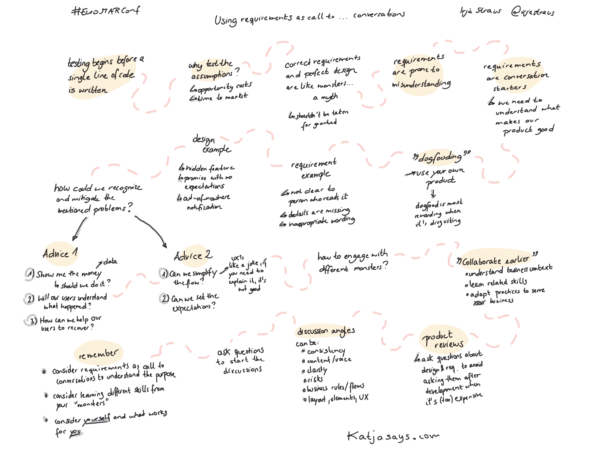
The Automationist’s Gambit
Maaret Pyhäjärvi
Some time ago Maaret learned about the Queen’ Gambit – a chess move in which white appears to sacrifice the c-pawn but then black not being able to retain pawn without incurring disadvantage in the end. She then thought about the Automationist’s Gambit – opening by sacrificing material to win in the end. Automation might not test everything, but still be very valuable. Even if at first your automation tests aren’t perfect, start small, learn the basics and then get better every day.
Traditionally test design and test execution as well as manual and automated tests were seen as separate things. With (contemporary) exploratory testing this has changed. In test execution a good example is regression testing: automation serves as a little spider web and if something hits the web, you can manually check that part. For test design approval testing is a good example: the computer, the automation, creats the paths, and the human, manually, observes them and either approves or diapproves these paths. So you can’t automate well without exploring. You can’t explore well without automating.
Test automation in the frame of exploratory testing can serve for:
- documenting
- extending reach
- alerting to attend
- guiding to detail
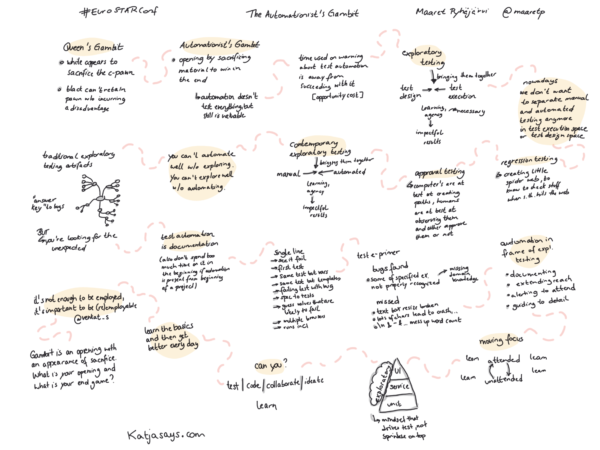
Frustrated? It might be your fault!
Jeffrey Fredrick & Douglas Squirrel
Our mind generates an illusion of certainty. We’ve been conditioned to act as though the illusion is reality. Our lack of skill in navigating our mutual illusions creates suffering. We have the option to learn to do better. All of us know what is required to get to a good decision, and yet our actual behaviour is different, especially when stakes are high. We want our idea to win, we see difference as threat and we don’t listen to others and don’t share all we know.
Jeffrey and Douglas presented the 4R Model for Conversational Analysis:
- Record: fold a paper in half – on the right side write down the visible part of the conversation, on the left side write down the unvisible part, meaning your thoughts and feelings
- Reflect: Be curious and ask if your questions are genuine, be transparent and think about what things from the left side could be on the right and think about the triggers that set of a negative reaction for you
- Revise: How could you’ve been curious and transparent – write down a revision
- Roleplay: Roleplay your revision and see how it sounds and feels
Through practice we can learn how to act in ways that encourage mutual learning. The result is higher performance of groups, better working relationships and improved well-being. If you don’t take time to practice and remain frustrated, it might be your fault.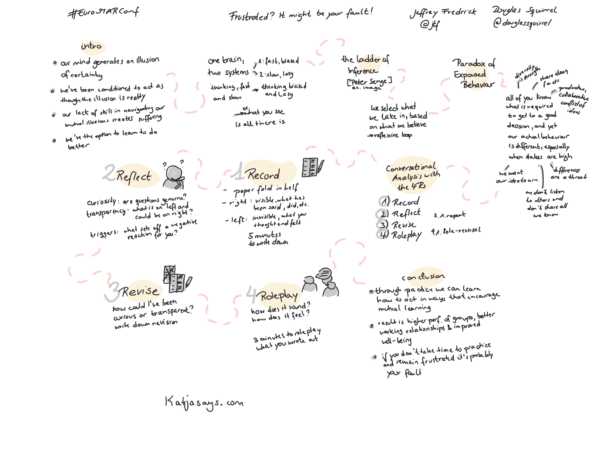
Continuous quality: The secret of the Pharaos
Adonis Celestine
When thinking about pyramids, it is astonishing that they are still standing, even after such a long time. This is because of their great quality. Adonis talked about the strategies of the pharaos and what we can learn from them for building continuous quality into our products.
The first strategy is the attention to details. The pharaos measured all stones, each and every one. Details define the quality, like Netflix customizing their pages for their users or Disney even engraving manholes in their parks with their logo. But details can also become the devil. Think about things like zero defect strategy, doing it right the first time, test coverage, questions about if the sprint can be completed or if the user stories have been automated.
The second strategy is thinking about the big pictures. The stones of a pyramid have to be placed in the right order. In quality assurance you have to use the following types of thinking:
- Purpose thinking: what is the real objective, ask the 5 whys – people don’t buy WHAT you do, they buy WHY you do it
- People thinking: it takes people to make the dream a reality, so think about what your users want
- Product thinking: what is the innovation and technology that makes a change in the world, you have to find products for your customers, not customers for your product
And the last strategy is to balance micro and macro views, meaning connecting the big picture to the details throughout your whole pipeline.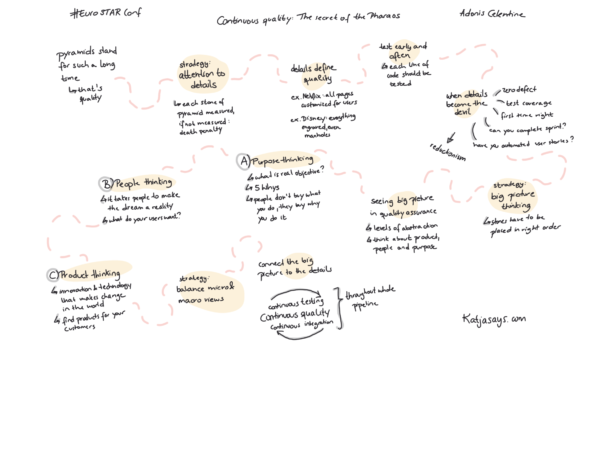
Engagement is a state of mind
Janet Gregory
The final keynote of the EuroSTAR Conference 2021 was held by Janet Gregory. She thinks that as a tester our role is to be engaged, which requires a special mindset. There is passive and active engagement, watching vs. taking part. Use uncertainty as an opportunity to grow.
Technical engagement is about practical skills to do your job, infrastructure, pipelines, tools, automation and domain complexity. Ask how well your product is built, what system/devices it runs on, if behaviour can be simulated, how the product interacts with the world around it. Ask if you have the right data and if you practice observability.
In human-centric engagement there are hidden assumptions, cognitive biases, different perspectives and cultures and all this also affects our testing. We engage with people like our teams, other teams, stakeholders or customers at different levels like sharing, mentoring, teaching or in conflict. Therefore we need to pay attention and be mindful when we work with people. Honour yourself, the people involved and the context you are in.
To be socially connected, you need a culture of helpfulness, collaborators and to build trust. As a tester you have to remember that testing isn’t a solitary job, relationships with others don’t just happen, you need to interact with your customer and that knowledge is meant to be shared.
So the skills for engaging with people are:
- communication
- listening
- emotional awareness
- adaptability
- empathy
- facilitation
- critical thinking
- collaboration

I can’t believe the EuroSTAR Conference 2021 is already over. Hopefully I’ll get the chance to attend the next edition and once again share my sketchnotes with all of you.
About The Author

Katja Budnikov is a software tester and sketch noter from Northern Germany. Katja is passionate about software testing and sketch noting! She loves attending events like EuroSTAR and sharing her experience and learnings with others on her blog Katjasays.com. Katja first started sketchnoting in 2016. First analogue with pen and paper and now digitally with an iPad and Apple Pencil.
In her work life Katja started out in online marketing, then specialized in search engine optimisation and is now a quality assurance specialist in both manual and automated software testing. Away from work Katja loves photography, especially taking photos of nature, including many of her dog Auri, a young Australian Shepherd, who is super cute and fun to take photos of. She loves to spend time with her dog and partner, going out for walks, traveling and eating cake at a nearby coffee shop with a beautiful garden.